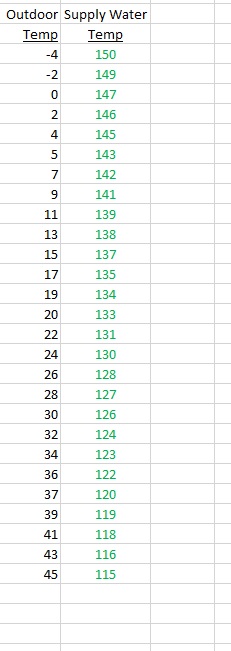Mind you, the Slantfin load tool is going to overestimate reality, sometimes by quite a bit, but it's way better than a WAG.
If you have a heating history on the place it's possible to run a pretty good
whole-house heat load calc based on wintertime meter readings (with a deduction for power use based on shoulder-season periods.) With the addition of wood heat it gets more complicated, but it's not impossible. That won't tell you how much heat load there is per zone or room, but you can work proportionally with Slantfin's numbers, but without a good handle on it just going with Slantfin's number would be close enough. It would oversize the radiation, but that's a GOOD thing for condensing efficiency.
Combi boilers are usually a LOUSY fit for most houses. They're better suited to large lossy houses with big heat loads but only moderate domestic hot water needs. The high minimum firing rate becomes really problematic if you're breaking it up into zones, since each zone has to be able to emit the lion's share of the min-fire output to avoid short cycling on zone calls.
The napkin-math on that can be found here.
The min-fire input of the 153P is 15,400 BTU/hr. At 95% combustion efficiency that's about 14,600BTU/hr out. With
typical fin tube at an average water temp (AWT) of 120F necessary to hit those efficiency numbers it would take about 70' of baseboard
PER ZONE to balance the boiler input to zone-radiation output.
Don't get to enamored of any particular solution until you have narrowed down on the heat loads per zone, and how much radiation it's going to take to deliver that much heat with an AWT of 14oF (assuming you're looking for condensing efficiency). There is no point to a modulating condensing boiler that's so oversized that can't condense or modulate. Sometimes you're better off using a condensing water heater with a heat exchanger separating the potable from the heating system water when breaking it up into zones. The thermal mass of the stored water keeps it from short cycling on zone calls even on micro-zoned systems- even zones with only 5' of baseboard.
Even with derating for altitude the house has to either large, leaky, or uninsulated (or all of the above) to need more than 80,000 BTU/hr of boiler. The design heat loads of a tight, insulated 2x4 framed 2500' house would usually come in under 60,000 BTU/hr @ -14F (the
99% outside design temp for Leadville.) For a 2200' raised ranch it'll be under 50,000 BTU/hr, maybe closing in on 40K @ -14F.
For a second-opinion on the Slantfin tool's numbers try
loadcalc. Like Slantfin, it too is prone to oversizing well into double-digit percentages compared to what a properly aggressive Manual-J on a professional tool would deliver. Make the most aggressive assumptions that are even remotely reasonable for air tightness and R-values and it'll still oversize by a bit.
Whatever load tool you use, set the air tightness to something very tight.The default settings for "typical" in most load tools assumes a much leakier house than would be tolerable for comfort (or even keeping the pipes from freezing) at 8300' in Colorado. Air leakage default settings are the single largest oversizing error for most freebie tools.

